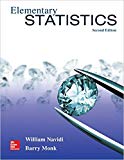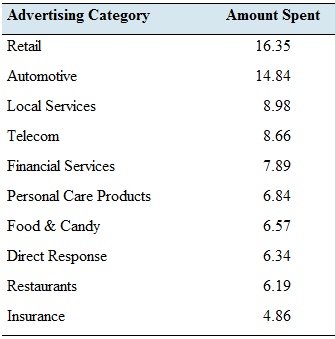
Concept explainers
Advertising costs: The amounts spent (in billions) on media advertising in the United States for a sample of categories are presented in the following table.

- Find the
mean amount spent on advertising. - Find the
median amount spent on advertising. - Find the sample variance of the advertising amounts.
- Find the sample standard deviation of the advertising amounts.
- Find the first
quartile of the advertising amounts. - Find the third quartile of the advertising amounts.
- Find the 40th percentile of the advertising amounts.
- Find the 65th percentile of the advertising amounts.
a)
To find mean.
Answer to Problem 12RE
Mean is 8.75.
Explanation of Solution
Given table:
| Amount spent |
| 16.35 |
| 14.84 |
| 8.98 |
| 8.66 |
| 7.89 |
| 6.84 |
| 6.57 |
| 6.34 |
| 6.19 |
| 4.86 |
Formula used:
Here n = 10.
Putting all values in formula,
Therefore, mean is 8.75.
b)
The median of given of amount spent.
Answer to Problem 12RE
Median is7.365.
Explanation of Solution
Given data sorted in ascending order:
| Amount spent |
| 4.86 |
| 6.19 |
| 6.34 |
| 6.57 |
| 6.84 |
| 7.89 |
| 8.66 |
| 8.98 |
| 14.84 |
| 16.35 |
Calculation:
Here n = 10 which is an even number.
Formula of median for even number is,
c)
To find sample variance.
Answer to Problem 12RE
Sample variance is 14.62.
Explanation of Solution
Creating table for sample standard deviation:
| 16.35 | 1.03 | 1.0609 |
| 14.84 | -0.48 | 0.2304 |
| 8.98 | -6.34 | 40.1956 |
| 8.66 | -6.66 | 44.3556 |
| 7.89 | -7.43 | 55.2049 |
| 6.84 | -8.48 | 71.9104 |
| 6.57 | -8.75 | 76.5625 |
| 6.34 | -8.98 | 80.6404 |
| 6.19 | -9.13 | 83.3569 |
| 4.86 | -10.46 | 109.4116 |
| Sum | 131.5 | |
Formula is,
Calculation:
From the table,
Put in a formula,
Sample variance = 14.62
d)
The sample standard deviation.
Answer to Problem 12RE
Sample standard deviation is 3.82.
Explanation of Solution
Sample variance is 14.62
Formula for sample standard deviation is,
e)
To find first quartile.
Answer to Problem 12RE
First quartile is 6.30.
Explanation of Solution
Given data sorted in ascending order:
| Amount spent |
| 4.86 |
| 6.19 |
| 6.34 |
| 6.57 |
| 6.84 |
| 7.89 |
| 8.66 |
| 8.98 |
| 14.84 |
| 16.35 |
Formula:
The first quartile is 6.30.
f)
The third quartile.
Answer to Problem 12RE
Third quartile is 10.445.
Explanation of Solution
Formula and calculation:
g)
To find 40th percentile is 6.678.
Answer to Problem 12RE
40th percentile.
Explanation of Solution
Given data sorted in ascending order:
| Amount spent |
| 4.86 |
| 6.19 |
| 6.34 |
| 6.57 |
| 6.84 |
| 7.89 |
| 8.66 |
| 8.98 |
| 14.84 |
| 16.35 |
Formula:
Since the position found is not an integer, the method of interpolation needs to be used. The 40% percentile is located between the values in positions 4 and 5. Those values, based on the data organized in ascending order, are 6.57 and 6.84.
The value of 4.4 - 4 = 0.4 corresponds to the proportion of the distance between 6.57 and 6.84 where the percentile we are looking for is located at.
Therefore,
h)
The 65th percentile.
Answer to Problem 12RE
65th percentile is 8.708.
Explanation of Solution
Since the position found is not integer, the method of interpolation needs to be used. The 65% percentile is located between the values in the positions 7 and 8. Those values, based on the data organized in ascending order, are 8.66 and 8.98.
The value of 7.15 - 7 = 0.15 corresponds to the proportion of the distance between 8.66 and 8.98 where the percentile we are looking for is located at.
Want to see more full solutions like this?
Chapter 3 Solutions
Elementary Statistics 2nd Edition
- Why researchers are interested in describing measures of the center and measures of variation of a data set?arrow_forwardWHAT IS THE SOLUTION?arrow_forwardThe following ordered data list shows the data speeds for cell phones used by a telephone company at an airport: A. Calculate the Measures of Central Tendency from the ungrouped data list. B. Group the data in an appropriate frequency table. C. Calculate the Measures of Central Tendency using the table in point B. 0.8 1.4 1.8 1.9 3.2 3.6 4.5 4.5 4.6 6.2 6.5 7.7 7.9 9.9 10.2 10.3 10.9 11.1 11.1 11.6 11.8 12.0 13.1 13.5 13.7 14.1 14.2 14.7 15.0 15.1 15.5 15.8 16.0 17.5 18.2 20.2 21.1 21.5 22.2 22.4 23.1 24.5 25.7 28.5 34.6 38.5 43.0 55.6 71.3 77.8arrow_forward
- II Consider the following data matrix X: X1 X2 0.5 0.4 0.2 0.5 0.5 0.5 10.3 10 10.1 10.4 10.1 10.5 What will the resulting clusters be when using the k-Means method with k = 2. In your own words, explain why this result is indeed expected, i.e. why this clustering minimises the ESS map.arrow_forwardwhy the answer is 3 and 10?arrow_forwardPS 9 Two films are shown on screen A and screen B at a cinema each evening. The numbers of people viewing the films on 12 consecutive evenings are shown in the back-to-back stem-and-leaf diagram. Screen A (12) Screen B (12) 8 037 34 7 6 4 0 534 74 1645678 92 71689 Key: 116|4 represents 61 viewers for A and 64 viewers for B A second stem-and-leaf diagram (with rows of the same width as the previous diagram) is drawn showing the total number of people viewing films at the cinema on each of these 12 evenings. Find the least and greatest possible number of rows that this second diagram could have. TIP On the evening when 30 people viewed films on screen A, there could have been as few as 37 or as many as 79 people viewing films on screen B.arrow_forward
- Q.2.4 There are twelve (12) teams participating in a pub quiz. What is the probability of correctly predicting the top three teams at the end of the competition, in the correct order? Give your final answer as a fraction in its simplest form.arrow_forwardThe table below indicates the number of years of experience of a sample of employees who work on a particular production line and the corresponding number of units of a good that each employee produced last month. Years of Experience (x) Number of Goods (y) 11 63 5 57 1 48 4 54 5 45 3 51 Q.1.1 By completing the table below and then applying the relevant formulae, determine the line of best fit for this bivariate data set. Do NOT change the units for the variables. X y X2 xy Ex= Ey= EX2 EXY= Q.1.2 Estimate the number of units of the good that would have been produced last month by an employee with 8 years of experience. Q.1.3 Using your calculator, determine the coefficient of correlation for the data set. Interpret your answer. Q.1.4 Compute the coefficient of determination for the data set. Interpret your answer.arrow_forwardCan you answer this question for mearrow_forward
- Techniques QUAT6221 2025 PT B... TM Tabudi Maphoru Activities Assessments Class Progress lIE Library • Help v The table below shows the prices (R) and quantities (kg) of rice, meat and potatoes items bought during 2013 and 2014: 2013 2014 P1Qo PoQo Q1Po P1Q1 Price Ро Quantity Qo Price P1 Quantity Q1 Rice 7 80 6 70 480 560 490 420 Meat 30 50 35 60 1 750 1 500 1 800 2 100 Potatoes 3 100 3 100 300 300 300 300 TOTAL 40 230 44 230 2 530 2 360 2 590 2 820 Instructions: 1 Corall dawn to tha bottom of thir ceraan urina se se tha haca nariad in archerca antarand cubmit Q Search ENG US 口X 2025/05arrow_forwardThe table below indicates the number of years of experience of a sample of employees who work on a particular production line and the corresponding number of units of a good that each employee produced last month. Years of Experience (x) Number of Goods (y) 11 63 5 57 1 48 4 54 45 3 51 Q.1.1 By completing the table below and then applying the relevant formulae, determine the line of best fit for this bivariate data set. Do NOT change the units for the variables. X y X2 xy Ex= Ey= EX2 EXY= Q.1.2 Estimate the number of units of the good that would have been produced last month by an employee with 8 years of experience. Q.1.3 Using your calculator, determine the coefficient of correlation for the data set. Interpret your answer. Q.1.4 Compute the coefficient of determination for the data set. Interpret your answer.arrow_forwardQ.3.2 A sample of consumers was asked to name their favourite fruit. The results regarding the popularity of the different fruits are given in the following table. Type of Fruit Number of Consumers Banana 25 Apple 20 Orange 5 TOTAL 50 Draw a bar chart to graphically illustrate the results given in the table.arrow_forward
 Big Ideas Math A Bridge To Success Algebra 1: Stu...AlgebraISBN:9781680331141Author:HOUGHTON MIFFLIN HARCOURTPublisher:Houghton Mifflin Harcourt
Big Ideas Math A Bridge To Success Algebra 1: Stu...AlgebraISBN:9781680331141Author:HOUGHTON MIFFLIN HARCOURTPublisher:Houghton Mifflin Harcourt Glencoe Algebra 1, Student Edition, 9780079039897...AlgebraISBN:9780079039897Author:CarterPublisher:McGraw Hill
Glencoe Algebra 1, Student Edition, 9780079039897...AlgebraISBN:9780079039897Author:CarterPublisher:McGraw Hill Holt Mcdougal Larson Pre-algebra: Student Edition...AlgebraISBN:9780547587776Author:HOLT MCDOUGALPublisher:HOLT MCDOUGAL
Holt Mcdougal Larson Pre-algebra: Student Edition...AlgebraISBN:9780547587776Author:HOLT MCDOUGALPublisher:HOLT MCDOUGAL



